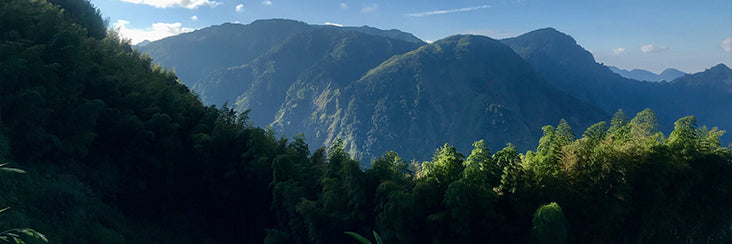
Long Feng Xia High Mountain Oolong Tea | Eco-Cha Tea Club

Long Feng Xia (龍鳳峽) or Dragon Phoenix Gorge is a deep river valley on the south side of the Shan Lin Xi High Mountain Tea growing region. Long Feng Xia is also the place name of the ridge overlooking this gorge, and is well known in Taiwan as the source of some of the best quality Shan Lin Xi High Mountain Oolong Tea.

First early morning light hitting the far ridge above Long Feng Xia
The micro-climate for most of the tea farms on this relatively small ridge offers ideal growing conditions for High Mountain Tea. Since this ridge is overlooking a massive gorge, it gets more sun exposure than the slopes along the much narrower valleys just north of it. The ridge is also more readily accessible to the year-round fog that rises almost daily from the valley floor, providing moisture and a substantial drop in temperature after the morning hours of high elevation sun. These are the essentials of ideal growing conditions: Daily sun and fog, providing a greater variation in temperature on a daily basis. In addition to these climate conditions, farm management and quality soil are also vital.

First light hitting the near ridge of Long Feng Xia
While the raw produce from these farms offers some of the best quality tea leaves, most of this produce is processed as a very minimally oxidized High Mountain Tea. This is mainly because it is the most reliable method for producing consistent quality and is the least labor and skill intensive. So this is how High Mountain Oolong was initially promoted when it was introduced in the 1980's — as a very fresh, fragrant green character. This was in stark contrast to the previously popular traditionally made teas, such as Dong Ding Oolong.
It's only in recent years that a growing, but still small number of cutting edge High Mountain Tea producers are opting for an alternative. They are of the conviction that slightly more oxidation, combined with more extensive drying at the final stage of processing, offers a quality of tea that is more satisfying and also more stable in its composition. The extensive drying mellows the flavor profile, giving it more body and depth. It also stabilizes the leaf, so that it maintains its original flavor — as opposed to the less oxidized, fresh green character of the conventionally made High Mountain Tea.

Sea of clouds engulfing the lower slopes in late afternoon
This is the reason why we are sharing this batch of tea with the Eco-Cha Tea Club. It's a prime example of this new trend in High Mountain Oolong Tea making. We find it to be superior in quality to the conventionally made, minimally processed High Mountain Tea that is very close to a Green Tea in its flavor profile as well as in its volatility and fragile shelf life. We see this method of tea processing as offering a value-added product that is more sustainable in its standard of quality than the more SOP/risk-free methods of tea making that the majority of High Mountain Tea producers follow.
Please let us know what your experience is, and how you think this subtle yet significant variation of tea processing suits your tea taste!
LET US KNOW!
We really want to know what you think! Leave your impressions or questions in the comment section below!
SUBSCRIBE!
If you enjoyed this post and would like to hear more about the specialty tea industry here in Taiwan, follow us on YouTube, Facebook, and Instagram and please subscribe to our newsletter. Subscribe now and get $5 off your first order!

